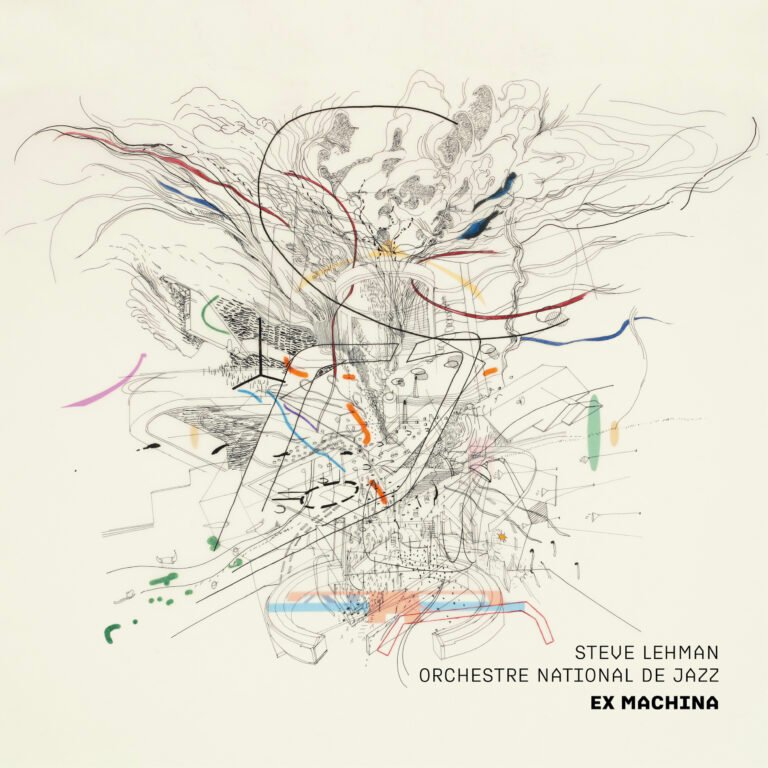
Ex Machina
Steve Lehman
Track List
- 39
- 8:02
- Los Angeles Imaginary
- 5:44
- Chimera
- 6:10
- Alchimie
- 3:02
- Ode to akLaff
- 6:24
- Jeux d'Anches
- 5:01
- Les Treize Soleils
- 5:36
- Speed-Freeze (part 1)
- 9:50
- Speed-Freeze (part 2)
- 8:44
- Le Seuil (part 1)
- 7:59
- Le Seuil (part 2)
- 4:31
Ex Machina, the new collaboration between visionary saxophonist / composer Steve Lehman and the GRAMMY-nominated Orchestre National de Jazz (ONJ), is a dazzling work that sets a new standard of innovation for large jazz ensembles. With compositions by both Lehman and ONJ’s artistic director, Frédéric Maurin, Ex Machina makes frequent use of otherworldly spectral harmonies that are reinforced and transformed, in real-time by live, interactive electronics developed at IRCAM (Institut de Recherche et Coordination Acoustique Musique, founded in 1977 by Pierre Boulez). Soloists in the ensemble interact with highly-nuanced harmonies, propulsive rhythms, and computer-driven sound transformations to thrilling effect. This ambitious project is indisputably a major conceptual step forward for jazz big band.
In many ways, Ex Machina represents an extension of Lehman’s work with his critically-acclaimed octet, whose groundbreaking recordings were the first to effectively utilize spectral harmony’s complex sonorities in a jazz context. The octet’s influential Mise en Abîme (Pi 2014) and Travail, Transformation and Flow (Pi 2009) was voted the #1 album of the year in the NPR Jazz Critics Poll and named the #1 jazz album of the year in The New York Times, respectively. Indeed, Maurin, who shares an affinity for spectral music, first met Lehman after a performance with his octet in Paris in 2016. After he was named the new director of ONJ he promptly commissioned Lehman to collaborate on a book of music rooted in these shared interests.
The new work also integrates interactive software developed by Jérôme Nika at IRCAM in which abstract electronic sounds react to solo improvisers in real-time while also proposing complex sonorities that augment the music’s existing harmonic structure. At many points throughout the piece, the computer becomes, in effect, a generator of virtual orchestrations and an improvising partner for the musicians. Indeed, the album’s name evokes spectral composer Grisey’s iconic “Tempus Ex Machina” as well as Lehman and Maurin’s inspired fusion of electronic sounds with traditional acoustic instrumentation.
While computer-driven improvisations pervade Ex Machina, it’s still the crack soloists of the ONJ along with Lehman and his long-time collaborators and octet members Jonathan Finlayson (trumpet) and Chris Dingman (vibraphone) who carry the day. “Los Angeles Imaginary” is built around torrid solo exchanges between Lehman, Finlayson, and ONJ tenor saxophonist, Julien Soro, while “Chimera” features a tour-de-force performance from Dingman, who opens the piece in shadowy dialogue with a computer-driven percussion soloist. On “Les Treize Soleils” ONJ flautist, Fanny Ménégoz, interacts with an ethereal, AI-generated sonic landscape, and pushes it to feverish heights, before eventually giving way to a fast, trancelike rhythm in 13/16. Still, in other works, Lehman and Maurin’s affinity for highly-nuanced orchestration, creates a unique environment for improvisation and group interaction. Maurin’s “Le Seuil (part 2)” opens with a series of massive tutti chords that somehow manages to be equal parts Gil Evans and Blade Runner 2049. Lehman’s “Jeux d’Anches” lives up to its namesake by combining the timbres of the ONJ woodwind section to create the sound of an imaginary reed organ.
Every track contains remarkable moments like these. Ex Machina is a meticulously crafted work that explores the intersection between cutting-edge composition and arrangement, interactive electronics, and jazz improvisation. The album represents an electrifying new concept for a jazz big band, and continues to position Lehman as a trailblazing artist at the cutting-edge of jazz.
Described as “one of the transforming figures of early 21st century jazz,” by The Guardian and as a “state-of-the-art musical thinker” by The New York Times, Steve Lehman is a composer, alto saxophonist, educator, and scholar who works across a broad spectrum of experimental musical idioms. In addition to leading his own acclaimed ensembles, he has performed and recorded with Anthony Braxton, Vijay Iyer, George Lewis, Bennie Maupin, Jason Moran, Georgia-Anne Muldrow, Meshell Ndegeocello, and High Priest of Antipop Consortium, among many others. Pitchfork pronounced that his latest project with his band Selebeyone, a synthesis of hip hop, jazz and electronic music is “legitimately new…a revelation.”
The Orchestre National de Jazz was created by France’s Ministry of Culture in 1986. It has played a large part in the institutional and cultural legitimization of jazz in France, notably in commissioning and offering a vast panorama of newly created works with artists like John Hollenbeck, Tim Berne, and many others. www.onj.org/en
Artistic director of the ONJ since January 2019, guitarist and composer Frédéric Maurin is widely celebrated throughout Europe for his innovative work with large jazz ensembles, including his long-standing big band Ping Machine, founded in 2005.